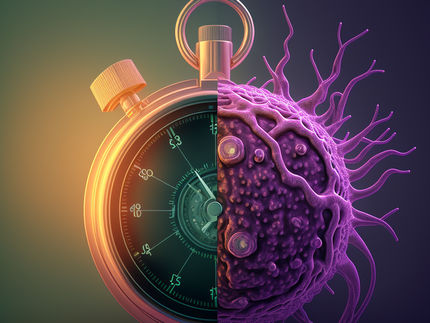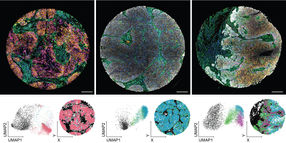New imaging technique accurately finds cancer cells, fast
The long, anxious wait for biopsy results could soon be over, thanks to a tissue-imaging technique developed at the University of Illinois. The research team demonstrated the novel microscopy technique, called nonlinear interferometric vibrational imaging (NIVI), on rat breast-cancer cells and tissues. It produced easy-to-read, color-coded images of tissue, outlining clear tumor boundaries, with more than 99 percent confidence – in less than five minutes.
Led by professor and physician Stephen A. Boppart, who holds appointments in electrical and computer engineering, bioengineering and medicine, the Illinois researchers will publish their findings in Cancer Research.
In addition to taking a day or more for results, current diagnostic methods are subjective, based on visual interpretations of cell shape and structure. A small sample of suspect tissue is taken from a patient, and a stain is added to make certain features of the cells easier to see. A pathologist looks at the sample under a microscope to see if the cells look unusual, often consulting other pathologists to confirm a diagnosis.
"The diagnosis is made based on very subjective interpretation – how the cells are laid out, the structure, the morphology," said Boppart, who is also affiliated with the university's Beckman Institute for Advanced Science and Technology. "This is what we call the gold standard for diagnosis. We want to make the process of medical diagnostics more quantitative and more rapid."
Rather than focus on cell and tissue structure, NIVI assesses and constructs images based on molecular composition. Normal cells have high concentrations of lipids, but cancerous cells produce more protein. By identifying cells with abnormally high protein concentrations, the researchers could accurately differentiate between tumors and healthy tissue – without waiting for stain to set in.
Each type of molecule has a unique vibrational state of energy in its bonds. When the resonance of that vibration is enhanced, it can produce a signal that can be used to identify cells with high concentrations of that molecule. NIVI uses two beams of light to excite molecules in a tissue sample.
"The analogy is like pushing someone on a swing. If you push at the right time point, the person on the swing will go higher and higher. If you don't push at the right point in the swing, the person stops," Boppart said. "If we use the right optical frequencies to excite these vibrational states, we can enhance the resonance and the signal."
One of NIVI's two beams of light acts as a reference, so that combining that beam with the signal produced by the excited sample cancels out background noise and isolates the molecular signal. Statistical analysis of the resulting spectrum produces a color-coded image at each point in the tissue: blue for normal cells, red for cancer.
Another advantage of the NIVI technique is more exact mapping of tumor boundaries, a murky area for many pathologists. The margin of uncertainty in visual diagnosis can be a wide area of tissue as pathologists struggle to discern where a tumor ends and normal tissue begins. The red-blue color coding shows an uncertain boundary zone of about 100 microns – merely a cell or two.
"Sometimes it's very hard to tell visually whether a cell is normal or abnormal," Boppart said. "But molecularly, there are fairly clear signatures."
The researchers are working to improve and broaden the application of their technique. By tuning the frequency of the laser beams, they could test for other types of molecules. They are working to make it faster, for real-time imaging, and exploring new laser sources to make NIVI more compact or even portable. They also are developing new light delivery systems, such as catheters, probes or needles that can test tissue without removing samples.
"As we get better spectral resolution and broader spectral range, we can have more flexibility in identifying different molecules," Boppart said. "Once you get to that point, we think it will have many different applications for cancer diagnostics, for optical biopsies and other types of diagnostics."
Other news from the department science
Most read news
More news from our other portals
See the theme worlds for related content
Topic world Diagnostics
Diagnostics is at the heart of modern medicine and forms a crucial interface between research and patient care in the biotech and pharmaceutical industries. It not only enables early detection and monitoring of disease, but also plays a central role in individualized medicine by enabling targeted therapies based on an individual's genetic and molecular signature.

Topic world Diagnostics
Diagnostics is at the heart of modern medicine and forms a crucial interface between research and patient care in the biotech and pharmaceutical industries. It not only enables early detection and monitoring of disease, but also plays a central role in individualized medicine by enabling targeted therapies based on an individual's genetic and molecular signature.





























































